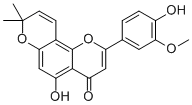RacemoflavoneCAS# 106055-12-3 |

Quality Control & MSDS
Package In Stock
Number of papers citing our products

| Cas No. | 106055-12-3 | SDF | Download SDF |
| PubChem ID | N/A | Appearance | Yellow powder |
| Formula | C21H18O6 | M.Wt | 366.39 |
| Type of Compound | Flavonoids | Storage | Desiccate at -20°C |
| Solubility | Soluble in Chloroform,Dichloromethane,Ethyl Acetate,DMSO,Acetone,etc. | ||
| General tips | For obtaining a higher solubility , please warm the tube at 37 ℃ and shake it in the ultrasonic bath for a while.Stock solution can be stored below -20℃ for several months. We recommend that you prepare and use the solution on the same day. However, if the test schedule requires, the stock solutions can be prepared in advance, and the stock solution must be sealed and stored below -20℃. In general, the stock solution can be kept for several months. Before use, we recommend that you leave the vial at room temperature for at least an hour before opening it. |
||
| About Packaging | 1. The packaging of the product may be reversed during transportation, cause the high purity compounds to adhere to the neck or cap of the vial.Take the vail out of its packaging and shake gently until the compounds fall to the bottom of the vial. 2. For liquid products, please centrifuge at 500xg to gather the liquid to the bottom of the vial. 3. Try to avoid loss or contamination during the experiment. |
||
| Shipping Condition | Packaging according to customer requirements(5mg, 10mg, 20mg and more). Ship via FedEx, DHL, UPS, EMS or other couriers with RT, or blue ice upon request. | ||

Racemoflavone Dilution Calculator

Racemoflavone Molarity Calculator
| 1 mg | 5 mg | 10 mg | 20 mg | 25 mg | |
| 1 mM | 2.7293 mL | 13.6467 mL | 27.2933 mL | 54.5866 mL | 68.2333 mL |
| 5 mM | 0.5459 mL | 2.7293 mL | 5.4587 mL | 10.9173 mL | 13.6467 mL |
| 10 mM | 0.2729 mL | 1.3647 mL | 2.7293 mL | 5.4587 mL | 6.8233 mL |
| 50 mM | 0.0546 mL | 0.2729 mL | 0.5459 mL | 1.0917 mL | 1.3647 mL |
| 100 mM | 0.0273 mL | 0.1365 mL | 0.2729 mL | 0.5459 mL | 0.6823 mL |
| * Note: If you are in the process of experiment, it's necessary to make the dilution ratios of the samples. The dilution data above is only for reference. Normally, it's can get a better solubility within lower of Concentrations. | |||||

Calcutta University

University of Minnesota

University of Maryland School of Medicine

University of Illinois at Chicago

The Ohio State University

University of Zurich

Harvard University

Colorado State University

Auburn University

Yale University

Worcester Polytechnic Institute

Washington State University

Stanford University

University of Leipzig

Universidade da Beira Interior

The Institute of Cancer Research

Heidelberg University

University of Amsterdam

University of Auckland

TsingHua University

The University of Michigan

Miami University

DRURY University

Jilin University

Fudan University

Wuhan University

Sun Yat-sen University

Universite de Paris

Deemed University

Auckland University

The University of Tokyo

Korea University
- 24-O-Acetyllycoclavanol
Catalog No.:BCX0294
CAS No.:13956-53-1
- Trijugin H
Catalog No.:BCX0293
CAS No.:1233534-55-8
- 5α,6α-Epoxy-3β-hydroxymegastigm-7-en-9-one
Catalog No.:BCX0292
CAS No.:50281-42-0
- 5-Hydroxynoracronycine
Catalog No.:BCX0291
CAS No.:27067-70-5
- Zedoalactone A
Catalog No.:BCX0290
CAS No.:170384-82-4
- 5-Deoxytrijugin C
Catalog No.:BCX0289
CAS No.:135971-83-4
- Zedoalactone B
Catalog No.:BCX0288
CAS No.:170384-81-3
- Zedoarolide B
Catalog No.:BCX0287
CAS No.:213833-36-4
- Trijugin B
Catalog No.:BCX0286
CAS No.:1233534-43-4
- Triumbelletin 7-O-glucoside
Catalog No.:BCX0285
CAS No.:2222584-03-2
- Ubine
Catalog No.:BCX0284
CAS No.:34469-09-5
- 3,4-Dihydroxy-N-(2-hydroxy-2-phenylethyl)benzamide
Catalog No.:BCX0283
CAS No.:1916734-50-3
- Trijugin G
Catalog No.:BCX0296
CAS No.:1233534-53-6
- Isoorientin 3'-O-glucoside
Catalog No.:BCX0297
CAS No.:53098-95-6
- 2-Ethyl-3-methylmaleimide
Catalog No.:BCX0298
CAS No.:20189-42-8
- Balsaminone B
Catalog No.:BCX0299
CAS No.:213271-56-8
- Acutumidine
Catalog No.:BCX0300
CAS No.:18145-26-1
- Epiloliolide
Catalog No.:BCX0301
CAS No.:147730-52-7
- Yunnancoronarin C
Catalog No.:BCX0302
CAS No.:260406-45-9
- Tanshinol B
Catalog No.:BCX0303
CAS No.:189290-30-0
- Spicatanol
Catalog No.:BCX0304
CAS No.:1158208-05-9
- (1S,16R)-1-Hydroxycryptotanshinone anhydride
Catalog No.:BCX0305
CAS No.:2301967-86-0
- Formononetin 7-O-β-D-apiofuranosyl-(1→6)-O-β-D-glucopyranoside
Catalog No.:BCX0306
CAS No.:857677-78-2
- Kushenol O
Catalog No.:BCX0307
CAS No.:102390-91-0
A new flavonoid from the leaves of Atalantia monophylla (L.) DC.[Pubmed:29600742]
Nat Prod Res. 2019 Apr;33(8):1115-1121.
A new flavonoid, atalantraflavone (1) as well as eight known compounds including atalantoflavone (2), Racemoflavone (3), 5,4'-dihydroxy-(3'',4''-dihydro-3'',4''-dihydroxy)-2'',2''-dimethylpyrano-(5'',6'':7,8)-flavone (4), lupalbigenin (5), anabellamide (6), citrusinine I (7), p-hydroxybenzaldehyde (8), and frideline (9), were isolated from the leaves of Atalantia monophylla (L.) DC. Focusing on Alzheimer's disease, acetylcholine esterase (AChE) inhibition and antioxidant activity were evaluated using the modified Ellman's method and the ABTS scavenging assay, respectively. It was found that isoflavonoid 5, lupalbigenin, showed 79% inhibition to AChE and was 1.4-fold stronger than the tacrine standard. In addition, acridone 7, citrusinine I, displayed 90.68% antioxidant activity.
[Study on Chemical Constituents of Peanut Hull].[Pubmed:26415405]
Zhong Yao Cai. 2015 Feb;38(2):302-4.
OBJECTIVE: To investigate the chemical constituents of peanut hull. METHODS: Several chromatography methods such as silica gel and Sephadex LH-20 combined with recrystallization were applied to isolate the compounds. Based on spectrum technologies (MS,1H-NMR and 13C-NMR) and physico-chemical methods, structures of isolated compounds were identified. RESULTS: Twelve compounds were isolated and elucidated as luteolin (1), diosmetin (2), 5,7,3',4'-tetrahydroxy-8-prenyflavone (3),5,7,3'-trihydroxy-4'- methoxy-8-prenylflavone(4), eriodicrtyol (5), Racemoflavone (6), hydnocarpin (7), 5,7-dihydroxy chromone (8), 5-hydroxy-chromone- 7-O-beta-D-glucoside (9), ferulic acid (10), beta-sitosterol (11) and daucosterol(12). CONCLUSION: Except compounds 1, 5 and 8, all compounds are obtained from peanut hull for the first time.


